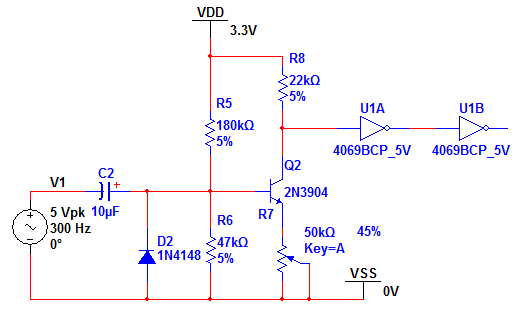Hello again,
As usual, I'm in trouble with a transistor circuit But I think I've learned a couple of things already (compared with my previous posts). Yet, as soon as I start modifying the circuit I hesitate. And I'm not sure if my assumptions are correct. Let's see:
But I think I've learned a couple of things already (compared with my previous posts). Yet, as soon as I start modifying the circuit I hesitate. And I'm not sure if my assumptions are correct. Let's see:
I have to measure an analog-signal frequency using both, an Arduino and a Raspberry Pi. For the Arduino case I've used a circuit like this:

Which, after being discussed in this thread I modified a little and worked fine. In the Raspberry Pi case, I want to improve the circuit. I'd like it to switch the transistor on with less than 700mV in the base. So I biased the base with a DC level using a circuit like the old class A amplifier. At first I connected the emitter to 0V but then I had noise being amplified. So I added a preset in order to modify Ve and thus modify the voltage needed at the base for turning on the transistor. I don't know if this is a good idea.
I stated (from the previous circuit) that Ic ≈ 150µA
β ≈ 100 and Vb = 700mV
Ib = 1.5µA
R1 = Vdd - 700mV / (Ib x 10) = 173kΩ
R2 = 700mV / (Ib x 10) = 47 kΩ

Now the problem here is the input signal es 5V peak to peak but my input circuit has 3.3V source (from RaspberryPi). So when the base is taken over 2.3V the transistor is turned off, as you can see here. I added two orange arrows in the graphic:

There are two questions then:
As usual, I'm in trouble with a transistor circuit
I have to measure an analog-signal frequency using both, an Arduino and a Raspberry Pi. For the Arduino case I've used a circuit like this:

Which, after being discussed in this thread I modified a little and worked fine. In the Raspberry Pi case, I want to improve the circuit. I'd like it to switch the transistor on with less than 700mV in the base. So I biased the base with a DC level using a circuit like the old class A amplifier. At first I connected the emitter to 0V but then I had noise being amplified. So I added a preset in order to modify Ve and thus modify the voltage needed at the base for turning on the transistor. I don't know if this is a good idea.
I stated (from the previous circuit) that Ic ≈ 150µA
β ≈ 100 and Vb = 700mV
Ib = 1.5µA
R1 = Vdd - 700mV / (Ib x 10) = 173kΩ
R2 = 700mV / (Ib x 10) = 47 kΩ

Now the problem here is the input signal es 5V peak to peak but my input circuit has 3.3V source (from RaspberryPi). So when the base is taken over 2.3V the transistor is turned off, as you can see here. I added two orange arrows in the graphic:

There are two questions then:
- Is the preset between emitter and ground a proper way for handling the base-voltage threshold?
- How do I limit the input for avoiding the 5V problem?
Last edited:










